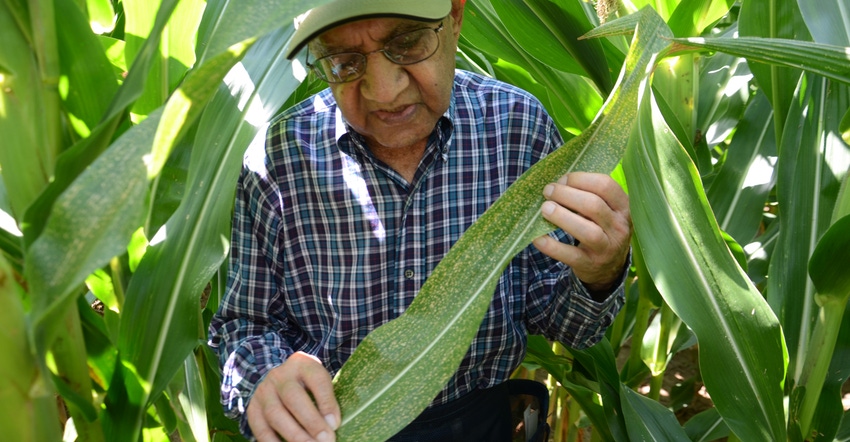
Imagine walking through a cornfield while leaves are still green. Disease pressure is low, so you’re seeing green leaf after green leaf. Suddenly, a plant pops out that you simply can’t ignore. Instead of solid green, its leaves are speckled, like someone dusted them with snowflakes or white confetti. That’s a scouting stopper — what is going on?
“I found one, and then I found two more, all within a relatively small area of maybe a quarter an acre,” says Dave Nanda, director of genetics for Seed Genetics Direct.
“The interesting thing was that every leaf on all three plants was speckled. There weren’t as many speckles on top leaves, but they were definitely there.”
Ruling out causes
Your first reaction is that it might be a disease, Nanda says. “Speckles weren’t black like tar spot, and they didn’t rub off,” he says. “They weren’t shaped like disease lesions, with decaying and dead tissue.
“Also, most diseases don’t affect all leaves up and down the plant at once. Foliar diseases typically affect lower leaves first, then move up the plant and affect upper leaves if conditions are right for the disease to spread.”
Nanda also ruled out a deficiency as being the likely cause. “We know that nitrogen starts with yellowing at the tip of the leaf and works in along the midrib,” he explains. “Potassium deficiency begins with yellowing and browning along the outer margins of corn leaves. There were plants with potassium deficiency symptoms, but not these plants. It didn’t match up with any known deficiency.”
Genetic cause
“The most likely explanation is that it’s some sort of genetic recessive trait which happened to show up in this hybrid,” Nanda says. “The spots without green color looked like they were missing chlorophyl for photosynthesis. The plant tissue that wasn’t green didn’t appear to be dying — it just wasn’t green.�”
Two of the three plants Nanda found appeared to have normal-size ears compared to their neighbors. The ear on one of the three was somewhat smaller with some pollination issues, but a few other ears on normal plants also showed pollination issues.
“Chances are it’s nothing to be concerned about,” Nanda says. “It’s just something you can’t help but notice, so you try to figure out why it’s there.” Since he only found three speckled plants out of thousands of plants he walked by, Nanda suspects the occurrence is very rare.

Finding off-type plants would be far more concerning, he says. “Remember that if it’s a Bt hybrid with refuge required, there will be plants from two hybrids in the field,” Nanda explains. “However, if you find plants that are obviously different — like taller or shorter, or perhaps tassels are very different — it could be a sign that the seed fields weren’t rogued well, and off-type plants produced seed.
“Too many off-type plants could affect yield because they may not have the same yield potential as the hybrid.”
About the Author(s)
You May Also Like




